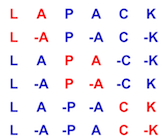 |
LAPACK 3.12.1
LAPACK: Linear Algebra PACKage
|
 |
LAPACK 3.12.1
LAPACK: Linear Algebra PACKage
|
| subroutine dptcon | ( | integer | n, |
| double precision, dimension( * ) | d, | ||
| double precision, dimension( * ) | e, | ||
| double precision | anorm, | ||
| double precision | rcond, | ||
| double precision, dimension( * ) | work, | ||
| integer | info ) |
DPTCON
Download DPTCON + dependencies [TGZ] [ZIP] [TXT]
!> !> DPTCON computes the reciprocal of the condition number (in the !> 1-norm) of a real symmetric positive definite tridiagonal matrix !> using the factorization A = L*D*L**T or A = U**T*D*U computed by !> DPTTRF. !> !> Norm(inv(A)) is computed by a direct method, and the reciprocal of !> the condition number is computed as !> RCOND = 1 / (ANORM * norm(inv(A))). !>
| [in] | N | !> N is INTEGER !> The order of the matrix A. N >= 0. !> |
| [in] | D | !> D is DOUBLE PRECISION array, dimension (N) !> The n diagonal elements of the diagonal matrix D from the !> factorization of A, as computed by DPTTRF. !> |
| [in] | E | !> E is DOUBLE PRECISION array, dimension (N-1) !> The (n-1) off-diagonal elements of the unit bidiagonal factor !> U or L from the factorization of A, as computed by DPTTRF. !> |
| [in] | ANORM | !> ANORM is DOUBLE PRECISION !> The 1-norm of the original matrix A. !> |
| [out] | RCOND | !> RCOND is DOUBLE PRECISION !> The reciprocal of the condition number of the matrix A, !> computed as RCOND = 1/(ANORM * AINVNM), where AINVNM is the !> 1-norm of inv(A) computed in this routine. !> |
| [out] | WORK | !> WORK is DOUBLE PRECISION array, dimension (N) !> |
| [out] | INFO | !> INFO is INTEGER !> = 0: successful exit !> < 0: if INFO = -i, the i-th argument had an illegal value !> |
!> !> The method used is described in Nicholas J. Higham, , SIAM J. Sci. Stat. Comput., Vol. 7, No. 1, January 1986. !>
Definition at line 115 of file dptcon.f.